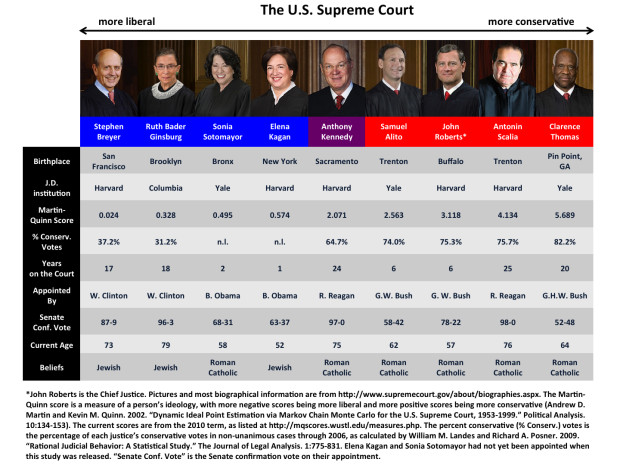The following article was originally published by Illinois Review.
With its wide range of ideologies, the Court has heroes for progressives, libertarians, and conservatives. And in the boxing ring of the Supreme Court chambers these justices engage in some of the highest-stake intellectual fisticuffs ever carried out.
Who are the nine people that decided the fate of Obamacare? It’s worth the time to examine the lives and characteristics of the members of the highest court in the land.
Two justices (Clarence Thomas and Samuel Alito) greeted the world in Trenton, New Jersey, and other justices hail from as far south as Pin Point, Georgia (Clarence Thomas), and as far west as San Francisco (Stephen Breyer). Interestingly, none of the justices were born in the Midwest.
Though some were born into humble circumstances and others enjoyed a wealthy upbringing, all justices obtained their law degrees from Ivy League institutions, with five attending Harvard, three attending Yale, and one attending Columbia.
This uniformity in choice of schools is not reflected in the justices’ ideologies, however. Given the amount of time many justices spend on the Court and the scope of cases they consider, there is a wealth of information about the political views of most of the Supreme Court justices. Two measures commonly used to compare justices’ ideologies are the Martin-Quinn score and the percent or fraction of conservative votes cast by a justice in non-unanimous decisions.
The Martin-Quinn score describes a justice’s political ideology for a given year by assigning more negative values to more liberal ideologies and more positive values to more conservative ideologies. In this way, the evolution of a given justice can be tracked over time, and justices can rapidly be compared to one another. For 2010, the court’s ideology as indicated by their Martin-Quinn scores ranged from 0.024 (Stephen Breyer) to 5.689 (Clarence Thomas). The median score was 2.071 (Anthony Kennedy’s, the most common swing vote). The justices range from casting a more conservative vote about 37.2% of the time (Stephen Breyer) to 82.2% of the time (Clarence Thomas).
How much time said heroes have spent on the Court or can expect to stay there varies widely. The average number of years the justices on this court have served is 13 years, but this disguises a bimodal distribution, with four justices having served six or less years, and five justices finishing 17-25 years on the bench. Liberal justices have spent 1-18 years on the Court, while conservative justices have spent 6-25 years there.
The fact that justices can exert their influence for a quarter century and more shows the breadth of influence a given administration can have years after the Oval Office has been redecorated. Five presidents can claim the current justices as their enduring legacy, with two current justices appointed by Ronald Reagan through Barack Obama, with the exception of H. W. Bush, who has only one appointee remaining. Notably, this appointee is Clarence Thomas, the most conservative justice currently serving on the Court.
The long-term influence of each justice explains the full vetting that each candidate should undergo, and the verbal flayings that some candidates have endured. Still, the confirmation process and final vote varies widely. Antonin Scalia and Anthony Kennedy were unanimously confirmed (98-0 and 97-0), while the Senate was most divided on Clarence Thomas (52-48), followed closely by Samuel Alito (58-42). Of the liberal justices, Ruth Bader Ginsburg faced the least opposition (96-3), and Elena Kagan faced the most (63-37). And, of course, we’re speaking only of those candidates who survived the potential borking.
The heterogeneity of the court extends further than ideology or vetting intensity. The justices range in age from 52 to 79, with an average age of 66. The most recent addition to the Court is also the youngest of all time: Elena Kagan, who is 52 years old. The two most elderly justices are Ruth Bader Ginsburg and Antonin Scalia, from the further ends of the ideological divide.
Another distinguishing factor are the justices’ religious views. The current justices are either Roman Catholic or Jewish, with a 6-3 split. Three of the four liberal justices are Jewish, and all of the more conservative justices in addition to Sonia Sotomayor are Roman Catholic.
All of the individual traits and choices of the justices—their upbringing, ideologies, etc.—impact their decisions in small and large ways. Hearing their interpretations of the Constitution as it pertains to some of the most pressing issues of our day is nerve-racking because we know every human, regardless of how well-educated, well-informed, or well-intentioned, is fallible.
We champion some justices and question others. We wonder just how flexible or forthright each justice will prove to be. In the midst of it all we can see the wisdom of our Founders in entrusting this power to a panel of justices instead of a single, omnipotent Supreme Court Justice. May this Court and every ensuing Court recognize and uphold the letter and the spirit of our highest law.

